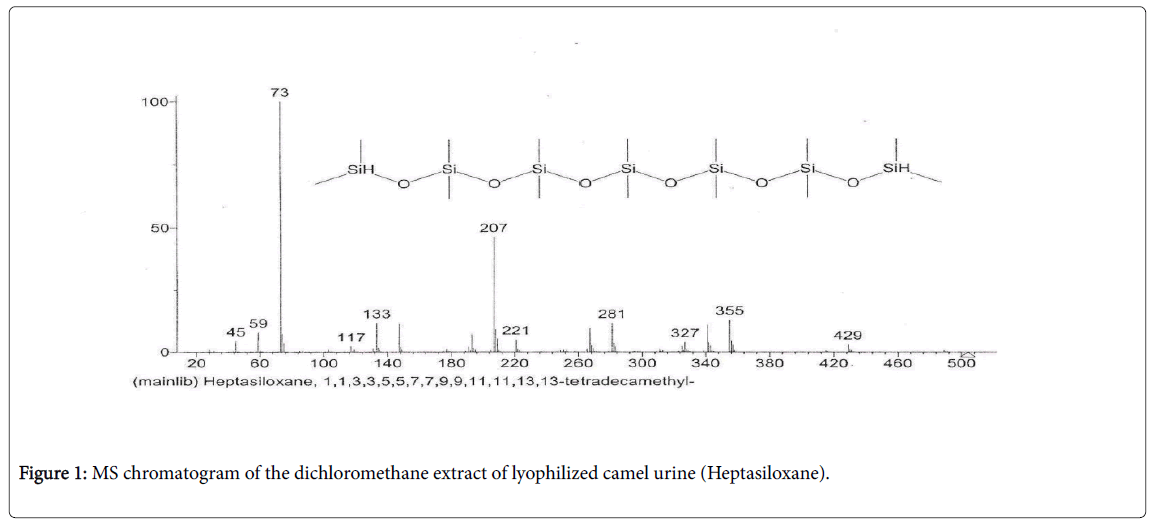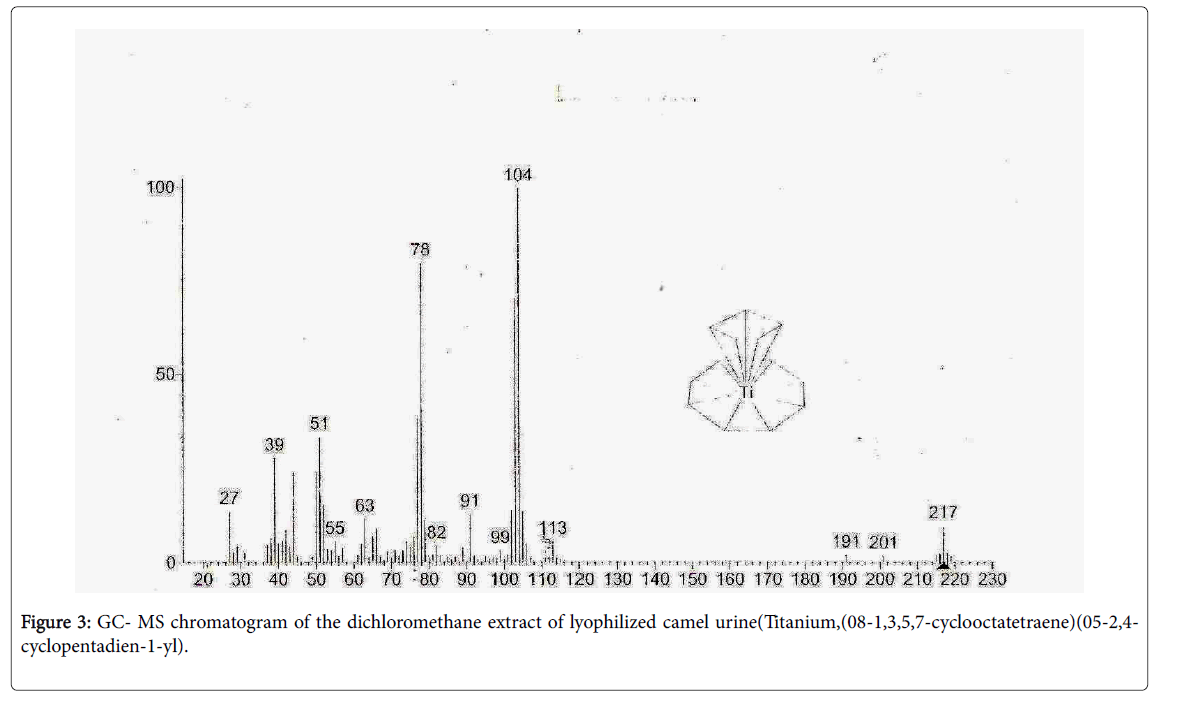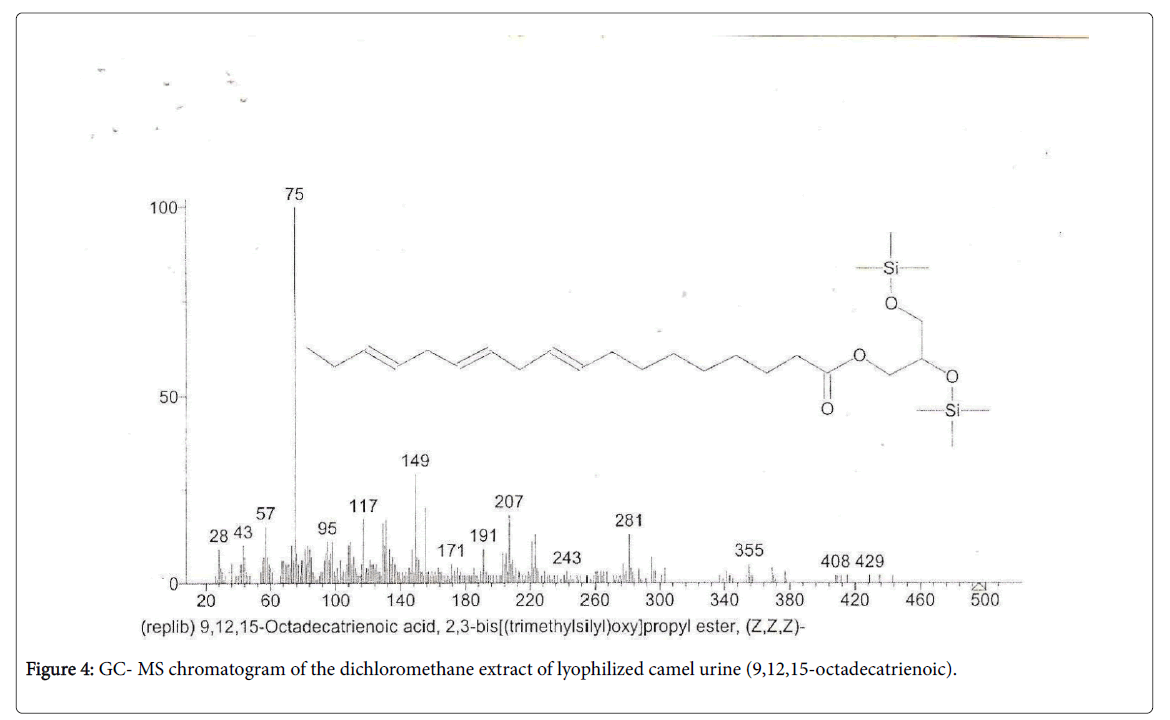Research Article Open Access
Novel Compounds in Lyophilized Female Camel Urine
Khogali ME Salwa1*, Elhassan MA bdalla2, Sara A Mohamed1 and Abdallh EA Barajob2
1Central Veterinary Research lab, Alamarat Khartoum, Sudan
2The National Ribat University, Faculty of Pharmacy, Khartoum, Sudan
- Corresponding Author:
- Salwa MEK
Department of Biochemistry, Nutrition,
Toxicology and Pharmacology, Central Veterinary Research Laboratory, Sudan
Tel: 916742300134
E-mail: salwamuhamed@hotmail.com
Received Date: February 25, 2016; Accepted Date: October 13, 2016; Published Date: October 17, 2016
Citation: Salwa MEK, Bdalla EMA, Mohamed SA, Barajob AEA (2016) Novel Compounds in Lyophilized Female Camel Urine. J Infect Dis Ther 4:296. doi: 10.4172/2332-0877.1000296
Copyright: © 2016 Salwa MEK, et al. This is an open-access article distributed under the terms of the Creative Commons Attribution License, which permits unrestricted use, distribution, and reproduction in any medium, provided the original author and source are credited.
Visit for more related articles at Journal of Infectious Diseases & Therapy
Abstract
The present work was done to emphasize the degraded compounds of camel urine. Lyophilized camel urine was analyzed by Gas chromatography mass spectrometry (GC-MS) Agilent 6890 GC. Eleven bioactive compounds were detected, four of these compounds have a novel structure, and these compounds are: 4-Heptanone,3-methyl, Butanoic Acid,butyl ester, Acetic Acid, (2,4,6-triethybenzoyl)thio, Benzoic Acid,methyl ester, Propane,2,2’- (methylenebis(oxy)bis(2-methyl-), Butane, 1,1-dibutoxy-, Pentanoic Acid, 4-oxo-, butyl ester, Benzoic Acid, butyl ester, Benzeneacetic Acid, 2-methylpropyl ester, Butylparaben. The four compounds of novel structure are: Titanium,(08-1,3,5,7-cyclooctatetraene)(05-2,4-cyclopentadien-1-yl),Nitroxidebis(1-1 dimethyleyl), 9,12,15- octadecatriaenoic acid, Hepta siloxane.
Keywords
Camel urine; Novel compounds; Gas chromatography
Introduction
Urine is a purified sterile product of blood filtration, medically referred to as plasma ultra-filtrate made by kidneys [1]. It has been shown throughout the history of medical science to this day, that urine has profound medical uses [2].
Use of animal urine is endorsed in mainstream modern medicine. Pregnant mare urine is the source of conjugated equine estrogens and has been marketed for over fifty years as pharmaceutical brand premarin, “an estrogen treatment for menopausal and pre-menopausal women” especially postpartum-one of the most prescribed drugs in United States [1]. It was very recently discovered that adding distilled cow urine to medicaments increases their effectiveness while decreasing their side-effects, making anti-cancer, anti-tubercular drug twenty times more effective and anti- bacterial eight times more effective (on line document), “urine therapy” is a stable of Ayurveda remedy [2,3].
Clinical studies on camel urine were recorded [4-10]. The results of these experiments proved that camel urine consists of many bioactive complex compounds, which can acts against bacterial, parasitic, carcinogenic agents and it has the ability to protect the liver against toxic agents [11].
Materials and Methods
Urine samples collected from natural grazing animals; then it was lyophilized using Analytical method.
Analytical method
Gas chromatography-Mass spectrometry (GC-MS) was performed using Agilent 6890 N network GC system interface, with a 60 m Agilent fused capillary column, DB-5 ms, 0.25 mm 1-D, 0.25 mm Film- initial temp 100°C, hold for 2 min, then programmed at 2°C/min to 300°c, isothermal temperature was held for 10 min.
Helium carrier gas, head pressure 9.30 psi, column flow 1 ml/min. injection temp 300°c EL source 230°C, total scan mode was cycled at 2 seconds. 1 ml of the given sample has been diluted with 10 ml of diethyl chloromethane (DCM), and 1 μ was injected using split less mode.
Results
Nist library was used for the identification of the compounds by comparison with published retention time of the chromatogram. Corrected areas % obtained by base line subtraction was used to calculate the percentage of the compounds within the injected amount.
GC-MS chromatogram of the dichloromethane extract of Camel urine, showed fourteen peaks indicating the presence of fourteen compounds.
Table 1 shows the retention time, the molecular weight and formulae and the peak area% of the detected compounds, Table 2 shows the biological activity of some detected compounds.
| Retention time | Name of compound | Molecular formula | Molecular weight | Peak area% |
|---|---|---|---|---|
| 8.13 | Titanium | C13H13Ti | 217 | 1.33 |
| 8.84 | 4-Heptanone, 3-methyl | C8H16O | 128 | 2.3 |
| 10.88 | Butanoic Acid, butyl ester | C8H16O2 | 144 | 2.23 |
| 14.87 | Acetic acid,(2,4,6-triethylbenzoylthio) | C15H20O3S | 280 | 1.9 |
| 15.03 | Benzoic acid, methyl ester | C8H8O2 | 136 | 8 |
| 17.76 | Propane,2,2’-(methylenebis(oxy)bis 2-methyl | C9H20O2 | 160 | 1.27 |
| 21.41 | Butane,1,1-dibutoxy | C12H26O2 | 202 | 26.59 |
| 21.67 | Pentanoic acid, 4-oxo-,butyl ester | C9H16O3 | 172 | 3.12 |
| 27.12 | Benzoic acid, butyl ester | C11H14O2 | 178 | 22.9 |
| 40.64 | Butylparaben | C11H14O3 | 194 | 27.71 |
| Nitroxidebis (1-1 dimethylelyl | C8H18NO | 292 | ||
| 71.73 | 9,12,15-Octadecatrienoic acid | C18H30O2 | 278 | 5.32 |
| Heptasiloxane | C16H48O6Si7 | 533 |
Table 1: Retention time, Molecular weight and formulae and Peak area % of the detected compounds.
| No | Name of compound | Activity |
|---|---|---|
| 1 | 4-Heptanone, 3Methyl | Anti-bacterial, Anti-fungal |
| 2 | Benzoic acid, butyl ester | Antiseptic, Anti-oxidant, Anti-cancer |
| 3 | Butylparaben | Anti-microbial |
| 4 | Nitroxid | Anti-oxidant, Anti-microbial |
| 5 | 9,12,15 octadecatienoic acid | Anti-oxidant, Anti-tumor, Anti inflammatory |
| 6 | Pentanoic acid, 4-oxo-, butyl ester | Anti-microbial |
| 7 | Benzoic acid, methyl ester | Anti-oxidant, Anti-microbial |
| 8 | Propane2,2-methylene bisoxy bismethyl | Anti-oxidant |
| 9 | Butanoic Acid, butyl ester | Anti-oxidant |
Table 2: Biological activity of some detected compounds.
Figure (1-4) show the GC- MS chromatogram of the dichloromethane extract of lyophilized camel urine (Heptasiloxane), Nitroxide bis (1-1 dimethyleyl), Titanium,(08-1,3,5,7- cyclooctatetraene)(05-2,4-cyclopentadien-1-yl) and 9,12,15 octadecatriaenoic acid, respectively [12].
Benzoic acid, methyl ester 1.3%, Propane-2,2-methylene bisoxy bismethyl 1.27%, Butanoic Acid, butyl ester 2.23%, Benzoic acid, butyl ester 22.9%, Nitroxid and 9,12,15 octadecatienoic acid were found in the urine extract that have an antioxidant activity, 9,12,15 octadecatienoic acid Butanoic acid, and Acetic acid Are have an anticancer effect [13].
Butanoic acid and Acetic acid also have an anti-microbial effect [13]. Benzoic acids and its esters are employed externally as antiseptics, lotions, ointments, creams and mouth washes. It is more effective as a preservative in foods and pharmaceutical products. Benzoic acid is an antiseptic but irritating, so used only externally. It is used in the treatment of burns, frostbite, chaps, cracks, erythema, pruritus, ulcers, infected dermatitis and other minor wounds [14].
4-Heptanone, 3-methyl which presented 2.3% [15], documented that, it has an anti-fungal effect.
Octadecatrienoic acid, (Z,Z,Z)- and Vitamin E which contributes the activities like antimicrobial, antioxidant anticancer, Hypercholesterolemic, Antiulcerogenic and other activities [16]. Butylparaben 27.71% was reported that, it has an anti-microbial effect [17].
References
- Christy M (2000) Your own perfect medicine.
- Natalie B (2002) Urine Therapy (drinking urine). Journal of Berkeley.
- Pieroni A, GrazziniA, GiustiME (2002) The sources of knowledge to the medicines of the future proceeding of the 4th European Colloquium of the Ethnopharmacology IRD Editions, Paris, France 371-375.
- Ohag HM (1993) Camel urine as medicament in sudan. B.Sc. Dissertation. Universty of Gezira.
- Ohag HM (1998) Clinical trials for treatment of ascites with camel urine M.Sc. Universty of Gezera, Sudan.
- Kabariti A, MazruaiS, Elgendi A (1988) Camel urine: A possible anti carcinogenic agent. Arab Gulf Journal of science research of Agricultural and biological sciences.
- Burzynski SR, Stolzmann Z, Szopa B, Stolzmann E, Kaltenberg OP (1977) Antineoplaston A in cancer therapy. Physiological Chemistry and Physics and Medical NMR9: 485-500.
- Khalifa MA (2003) Anti-bacterial effect of camel urine (CamelusDromedarius).University of Khartoum. Sudan.
- Wisal GA (2002) Anti-bacterial and Anti-fungal effect of camel urine (CamelusDromedarius). University of Khartoum. Sudan.
- Khogali SME (2006) Therapeutic applications of she-camel urine: pathological changes in cattel infected with Fasciolosis. Albuhuth 10:109-122.
- Khogali SME (2009)Hepatoprotective effect against Carbontetrachlorideinduced hepatotoxcicity in rats. J SciTechnol10:128-134.
- David Bamford (2001) On line document.
- Wei LS, Wee W, Siong JYF, Syamsumir DF (2011) Characterization of Antimicrobial, Antioxidant, Anticancer Property and Chemical Composition of Micheliachampaca Seed and Flower Extracts. Stamford j pharmsci4: 19-24.
- Britto AJD, Selvakymari PAS (2006) GC-MS study of the oil fraction of methanol extract of the Corm Typhoniumroxburghii. J Med Arom Plants 28: 578-579.
- da Silva Medeiros RT, Gonçalez E, Felicio RC, Felicio JD(2010) Evaluation of antifungal activity of Pittosporumundulatum L. essential oil against Aspergillusflavus and aflatoxin production. Ciência e Agrotecnologia35: 71-76.
- Kumar P, Kumaravel S,Lalitha C(2010) Screening of antioxidant activity, total phenolics and GC-MS study of Vitexnegundo, African Journal of Biochemistry Research4: 191-195.
- Yamaguchi M, AsakaY, Tanaka M, Mitsui T, OhtaS (1982)Antimicrobial activity of butylparaben in relation to its solubilization behavior by nonionic surfactants. Journal of the Society of Cosmetic Chemists 33: 297- 307.
Relevant Topics
- Advanced Therapies
- Chicken Pox
- Ciprofloxacin
- Colon Infection
- Conjunctivitis
- Herpes Virus
- HIV and AIDS Research
- Human Papilloma Virus
- Infection
- Infection in Blood
- Infections Prevention
- Infectious Diseases in Children
- Influenza
- Liver Diseases
- Respiratory Tract Infections
- T Cell Lymphomatic Virus
- Treatment for Infectious Diseases
- Viral Encephalitis
- Yeast Infection
Recommended Journals
Article Tools
Article Usage
- Total views: 11642
- [From(publication date):
October-2016 - Nov 21, 2024] - Breakdown by view type
- HTML page views : 10918
- PDF downloads : 724




